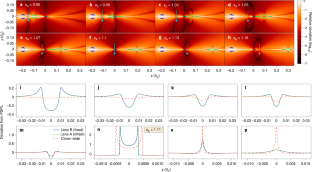2022-05-24 カリフォルニア大学バークレー校(UCB)
一般相対性理論から生じる複雑な数学の中に隠された、思いもよらない関連性、特に、他の星の周りにある新しい惑星を見つけるためにその理論をどのように適用するかということです。
研究者らは『Nature Astronomy』誌に発表した論文で、惑星系が背景の星の前を通過して一瞬明るくなったときに、惑星系をより迅速に検出するために開発したAIアルゴリズム(重力マイクロレンズと呼ばれるプロセス)が、これらの観測を説明するために現在使われている数十年前の理論がひどく不完全であることを明らかにしたことを述べています。
<関連情報>
- https://news.berkeley.edu/2022/05/24/ai-reveals-unsuspected-math-underlying-search-for-exoplanets/
- https://www.nature.com/articles/s41550-022-01671-6
2体マイクロレンズ系におけるユビキタスな統一的縮退 A ubiquitous unifying degeneracy in two-body microlensing systems
Keming Zhang,B. Scott Gaudi & Joshua S. Bloom
Nature Astronomy Published:23 May 2022
DOI:https://doi.org/10.1038/s41550-022-01671-6

Abstract
While gravitational microlensing by planetary systems1,2 provides unique vistas on the properties of exoplanets3, observations of a given two-body microlensing event can often be interpreted with multiple distinct physical configurations. Such ambiguities are typically attributed to the close–wide4,5 and inner–outer6 types of degeneracy, which arise from transformation invariances and symmetries of microlensing caustics. However, there remain unexplained inconsistencies (see, for example, ref. 7) between the aforementioned theories and observations. Here, leveraging a fast machine learning inference framework8, we present the discovery of the offset degeneracy, which concerns a magnification-matching behaviour on the lens axis and is formulated independently of caustics. This offset degeneracy unifies the close–wide and inner–outer degeneracies, generalizes to resonant topologies and, upon reanalysis, not only appears ubiquitous in previously published planetary events with twofold degenerate solutions, but also resolves prior inconsistencies. Our analysis demonstrates that degenerate caustics do not strictly result in degenerate magnifications and that the commonly invoked close–wide degeneracy essentially never arises in actual events. Moreover, it is shown that parameters in offset-degenerate configurations are related by a simple expression. This suggests the existence of a deeper symmetry in the equations governing two-body lenses than previously recognized.



